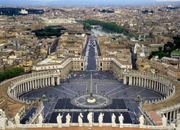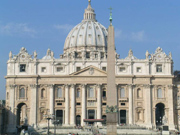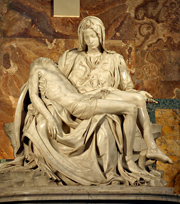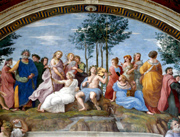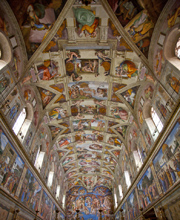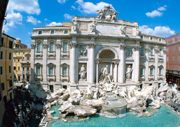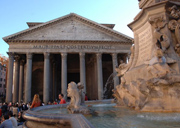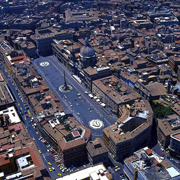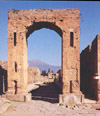
SHORE EXCURSION FOR DISABLED TO ROME FROM CIVITAVECCHIA PORT (VATICAN MUSEUMS, SISTINE CHAPEL, ST. PETER'S, TREVI FOUNTAIN, PIAZZA NAVONA - PANTHEON)
Details
SHORE EXCURSION OF ROME WITH DEPARTURE FROM THE PORT OF CIVITAVECCHIA FOR VISITING THE VATICAN MUSEUMS, SISTINE CHAPEL, ST. PETERíS BASILICA, TREVI FOUNTAIN, THE PANTHEON AND PIAZZA NAVONA
You can rent a wheelchair with us for one or more days.
|
DURATION: |
9 hours |
|
|
PRICE: |
View the price list | |
|
AVAILABILITY: |
All-year-round | |
| THE PRICE INCLUDES: | English-speaking Driver & Air-conditioned Mercedes Car at your disposal for 9 hours English-speaking Guide for the visit of Rome for 3 hours THE ENTRANCE FEES AND THE RESERVATION IMPORTANT INFORMATION: | |
SCHEDULE OF THE DAY TOUR TO ROME FROM THE PORT OF CIVITAVECCHIA FOR WHEELCHAIR USERS
|
| Meet with the English-speaking driver and his Mercedes limousine (with air conditioning) by the cruise ship at the Port of Civitavecchia |
| Arrival in Rome and meet with Your English-speaking expert guide at the Vatican Museums |
| 3-hour guided visit of the Vatican Museums, the Sistine Chapel and St. Peterís Basilica |
| 1 hour of free time for lunch (not included in the price) |
| Pick-up at the Vatican area and short drive to reach the Trevi Fountain in the centre of Rome |
| 2 hours of free time for the visit on Your own of the Trevi Fountain, the Pantheon and the Piazza Navona (without guide) |
| Pick-up close to the Piazza Navona and back to the Port of Civitavecchia |
This tour route, designed specifically for the disabled, is completely step-free. To avoid the stairs situated in the Vatican Museums, near the Sistine Chapel, and at the entrance to St. Peterís Basilica, You will use a combination of elevators, ramps, and wheelchair lifts.
VATICAN MUSEUMS:
The buildings that house the Vatican Museums, know collectively as the Palazzo Apostolico Vaticano, cover an area of 5.5 hectares. Each gallery contains priceless trasures. The most important are the Stanze di Raffaello, the Pinacoteca, the Galleria delle Carte Geografiche (Map Gallery) and, of course, the Sistine chapel. Among the pictures in the Pinacoteca you'll find Raphaelís last work, La Trasfigurazione, and pain by Giotto, Bellini, Caravaggio and Leonardo da Vinci, whose San Gerolamo was never finished. Through the superb Galleria delle Carte Geografiche (Map Gallery) and the Galleria degli Arazzi (Tapestry Gallery) are the magnificent Stanze di Raffaello, the private apartments of Pope Julius II. Raphael himself painted the Stanze della Segnatura and the Stanza d'Eliodoro, while the Stanza dell'Incendio was painted by his students to his designs and the ceiling was painted by his master, Perugino.
SISTINE CHAPEL & S. PETERíS BASILICA:
The Sistine Chapel is the room into which the papal conclave is locked to elect the next pope, although itís better know as home to the most famous works of art in the world: Michelangeloís frescoes on the barrel-vaulted ceiling, and the Last Judgement on the end wall (completed in 1541). The chapel was originally built in 1484 for Pope Sixtus IV, after whom it is named, but it was actually Julius II who commissioned Michelangelo to decorate it. The frescoes down the middle represent nine scenes from he book of Genesis, including the Division of Day from Night, the Creation of Adam, the Expulsion of Adam and Eve from the Garden of Eden and the flood.
The S. Peterís Basilica is not only huge, but also a monument to artistic genius. The first basilica was built here by Romeís first Christian emperor, constantine, in the 4th century. More than 1000 years later the basilica had fallen into disrepair. In the mid-15th century Nicholas V took a stab at its reconstruction, but it was not until 1506, when Julius II employed Bramante, that serious work began. It took more thatn 150 years to complete the new basilica, now the second biggest in the world. Bramante, Raphael, Antonio da Sangallo, Giacomo della Porta and Carlo Maderno, all contributes, but it is generally held that St. Peterís owes most to Michelangelo, who took over the project in 1547 at the age of 72 and was responsible for the design of the dome.
TREVI FOUNTAIN:
Immortalised by a frolicking Anita Ekberg in Felliniís film La DOlce Vita, the Trevi Fountain is Romeís most famous fountain. The baroque bonanza was desigend by Nicola Salvi in 1732 and depicts Neptuneís chariot being led by Tritons with sea horses - one wild, one docile - representing the various moods of the sea. The water comes from one of the cityís earliest aqueducts and the name Trevi refers to the tre vie (three roads) which converge at the fountain.
PANTHEON:
Built between 27 and 25 B.C. by the consul Agrippa, prefect of the Emperor Augustus, the present building is the result of subsequent, heavy restructuring. Its name of the Pantheon in Rome comes from two Greek words: pan, "everything" and teon "divine". So, originally, the Pantheon was a small temple dedicated to all Roman gods.
Domitian, in 80 A.D., rebuilt it after a fire; thirty years later it was hit by lightening and caught fire again. It was then rebuilt in its present shape by the Emperor Hadrian; under his reign, Rome reached its maximum splendour, and the present structure is probably the fruit of his eclectic genius and exotic tastes.
In fact, the Pantheon combines a clearly Roman, cylindrical structure with the splendid outer colonnade of Greek inspiration. Although the new structure was very different to the original, Hadrian wanted a Latin inscription on the faÁade, that translated means: It was built by Marcus Agrippa, son of Lucius, consul for the third time.
PIAZZA NAVONA:
Piazza Navona in Rome was built on the former Stadium built by Emperor Domitian in 86 AD: hence the long, oval shape of the square. The stadium, which had a larger arena than the Colosseum, was mainly used for festivals and sporting events.
The stadium was known as "Circus Agonalis" (competition arena) and over the centuries its name changed into "in agone" to "navone" and eventually to "navona".
In the XV century the stadium was paved over to create the Navona square, but traces of Domitianís stadium are still visible around the area.
The main attraction of Piazza Navona is the trio of fountains that adorn the square. The central and largest fountain is the Fontana dei Quattro Fiumi (Fountain of the Four Rivers). It was constructed between 1647 and 1651 on request of pope Innocent X. The design of the fountain was first commissioned to Borromini, but it was ultimately handed to his rival Bernini. The fountain features four figures, each representing a river from a different continent - the Nile, Ganges, Danube and Rio de la Plata.
The two other fountains on the piazza are the Fontana del Nettuno (Neptune fountain) at the northern end and the Fontana del Moro (Moor fountain) at the southern end of the square.
The Fontana del Nettuno, also known as the Calderari, was built in 1576 by Giacomo della Porta. The statues of Neptune surrounded by sea nymphs were added in the XIX century.
Giacomo della Porta also built the Fontana del Moro. The central statue of a Moor holding a dolphin, a design by Bernini, was added in the XVII century. The tritons are XIX century additions.
Another highlight at Navona square is the Church of Sant'Agnese in Agone. It was commissioned in 1652 by Pope Innocent X and built on the site where according to legend, St. Agnes was stripped naked, but miraculously saved from disgrace by extraordinary growth of hair.
The front facade of the Baroque church was designed by Borromini, Berniniís main rival.
Take water, camera & sun cream. In low season warmer clothing may be required!
